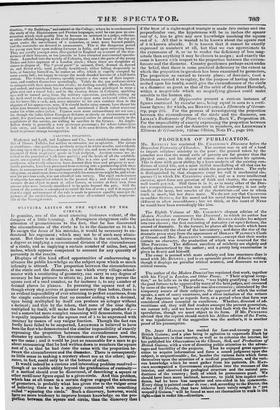OLIVEIRA LEITAO ON THE SQUARE OF THE CIRCLE.
IF genuine, one of the most amusing instances extant, of the dangers of a little learning. A Portuguese clergyman calls the attention of geometricians to the fact, that he has discovered the circumference of the circle to be to the diameter as 16 to 5. To assign the locus of his mistake, it would be necessary to un- derstand his argument ; which may not be of such easy attain- ment. But there is an ominous confusion in the outset, between a degree as implying a conventional division of the circumference of a circle, and as implying a certain number of miles, feet, and inches, which appears competent to account for any quantity of perversity in the results.
Displays of this kind afford opportunities of endeavouring to advance the public knowledge on the subject upon which so much infirmity is uttered. The proportion between the circumference of the circle and the diameter, is one which every village school- master with a smattering of geometry, can carry to any degree of accuracy he has patience to attain to; just as be may pursue the square root of a surd number, as for instance 5, to any Lumber of decimal places he pleases. In pursuing the square root of 5, though every step arrives at greater accuracy than before, there is an evident impossibility of ever attaining to perfect exactness, from the simple consideration that no number ending with a decimal, upon being multiplied by itself can produce an integer without a decimal; and this by the token, that none of the nine digits multiplied by itself, will make the last figure of the product 0 ;— and a somewhat more complex reasoning will demonstrate, that it is equally impossible for the square root of 5 to be expressed with accuracy by means of any vulgar fraction. Though the fact can hardly have failed to be suspected, LEGENDRE is believed to have been the first who demonstrated the similar impossibility of exactly expressing the proportion between the circumference and the diameter by numbers. The circumstances of the cases, however, are the same ; and it would be just as reasonable for a man to go about announcing that he had written down in numbers the square root of 5, as that he had done the same with the proportion be- tween the circumference and the diameter. There is consequently as little sense in making a mystery about one as the other; igno- rance, in fact, could only be at the bottom of either. It would indeed be a curious and interesting proble'm resolved— though of no visible utility beyond the gratification of curiosity— if a method should ever be discovered, of describing a square or other rectilinear figure equal to a given circle. And this problem, which has at all times to a certain degree engaged the attention of geometers, is probably what has given rise to the vulgar error of believing there to be a mystery connected with something called " squaring the circle." Such a discovery, however, would hia.ve no more tendency to improve human knowledge on the pro- portion between the square and circle, than the discovery that if the base of a right-angled triangle is made two inches and the perpendicular one, the hypotenuse will be in inches the square root of 5, has to give any new knowledge touching the square root of 5. All that is wanted to be known about the square root of 5 is known already. It is known that it cannot be exactly expressed in numbers at all, but that we can approximate to the expression of it, so 'as to render the deficiency of less mag- nitude than anything it may be chosen to assign ; and exactly the same is known with respect to the proportion between the circum- ference and the diameter. Country gentlemen perhaps exist under the belief, that there is some practical deficiency in the extent to which the proportion in question has been examined by geometers. The proportion as carried to twenty places of decimals, (and a Dutchman carried it to eighty, for the purpose of having them in- sei ibed upon his tomb), would give the circumference of the circle to a diameter as great as that of the orbit of the planet Herschel, within a magnitude which no magnifying.glasses could make. sensible to the human eye. The lunulee of Hippocrates present a curious instance of figures contained by circular arcs, being equal in area to a recti- linear figure; for which, see BoNNVCASTLE'S Elements of Geome- try, page 288. For the process of investigating the proportion " between the circumference of the circle and the diameter, see LESLIE'S Rudiments of Plane Geometry, Book V., Proposition 20. For the impossibility of exactly expressing the proportion between the circumference and the diameter in numbers, see LEGENDRE'S Elemens de Geometrie, 12eme edition, Note IV., page 289.


























 Previous page
Previous page